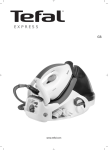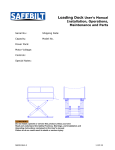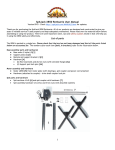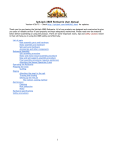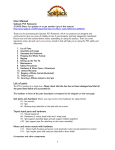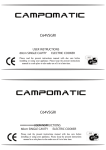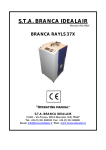Download USER`S MANUAL - Best Friend Mobility
Transcript
USER’S MANUAL SitGo™ Collapsible Rear Leg Support Dog Wheelchair (Large adjustable to XL) TABLE OF CONTENTS INTRODUCTION ........................................................................ 1 PRODUCT INFORMATION ........................................................... 2 The SitGo Motion ........................................................... 3 Measure Your Pet ........................................................... 4 ASSEMBLY ............................................................................... 6 Breakdown of Pre-assembled Parts .................................. 6 Assembling the Wheelchair ............................................. 10 FITTING YOUR DOG TO THE WHEELCHAIR ................................... 21 ADDITIONAL MEASUREMENTS .................................................... 33 CARE AND MAINTENANCE .......................................................... 34 CONTACT US ............................................................................ 35 INTRODUCTION Best Friend Mobility® Rehabilitation Aids Dear Pet Owner and Valued Customer: The following guidelines, along with the attached assembly and fitting instructions, will help you get the best use of your dog wheelchair. Please read and follow the Assembly instructions carefully before making any attempt to place your pet in the wheelchair. Should you encounter any problems with assembly and fitting, please call Best Friend Mobility directly through our hotline (843) 492-5283. If you think you need a different size, we can process the exchange for you easily. Just contact us at [email protected] or call our hotline. This is a learning process and can take time. We realize that both you and your pet are most likely unfamiliar with the use of a dog wheelchair so do not hesitate to contact us for help. Please be advised that most dogs do not intuitively know how to use a wheelchair, and they will require training and practice. Some dogs may be afraid in the beginning, so it is important to give positive reinforcement when placing them in the chair, especially for the first time. Use treats. Treats held in front of your pet will encourage it to take steps and move forward; this will teach them to ambulate while in the chair. It may take several training sessions before a dog is able to actually use the chair. It is okay and normal if your dog does not take to the chair right away. It is very important, especially with skittish animals, that they come into physical contact with the wheelchair in some way every day. This should always be coupled with positive reinforcement like praise, pets, and treats. This will help to create a positive association with the wheelchair and help the animal to eventually love the wheelchair and be able to learn to use it. This process may take from days to months, so please don’t lose hope, persistence will pay off. Contact us for any help or questions. Thank you for purchasing a Best Friend Mobility dog wheelchair. Again, we love receiving feedback, stories, photos, and videos of how your pets are doing in their wheelchairs. Sincerely, Tim Cantrell TIM CANTRELL Vice President Best Friend Mobility Phone: (843) 492-5283 1 Attention First Time Users It is important to acclimatize your pet to the wheelchair. It is recommended that you do not allow your pet to use the collapse or SitGo function for the first few weeks of use. You can set your pet’s wheelchair to non-collapsible manually. The instructions on how to set the wheelchair from collapsible to non-collapsible is in section 6.2 under the section “Assembling the Wheelchair.” This will deactivate the collapse or SitGo motion function. Wait until your pet gets comfortable using the wheelchair before you set the wheelchair to the collapsible setting. The instructions on how to release the setting from noncollapsible to collapsible is in section 6.1 under “Assembling the Wheelchair.” Once you set the wheelchair to the collapsible setting, you must then set the proper tension for your pet’s weight. The instructions for adjusting the tension for your pet’s weight are in section 7. DO NOT LEAVE YOUR PET ALONE IN THE CART! PRODUCT INFORMATION It’s finally here! The SitGo, Best Friend Mobility’s revolutionary pet wheelchair that allows our best buds not only to get up and go but also to sit and relax even in their wheels! Still made of the same durable, lightweight materials as our rear leg and quad support wheelchairs, the SitGo is the first of its kind to allow for voluntary sitting and lying down. And, because the rear can be lowered, getting your dog in the wheelchair— especially if he or she is big and heavy—becomes an easier, no-lifting operation. 2 SitGo Series Collapsible Chairs Then Your Pet Can Back Up By Him/Herself Simply By Moving Forward Your Pet Simply Backs Up Then Sits Or Lies Down The SitGo Motion The SitGo is truly revolutionary! It is the only wheelchair available in the market that gives a pet the option to sit or lie down even while on its wheelchair. No unstrapping necessary. It allows for a more natural flow of movement. A pet can run around, sit, play, lie down, and run around some more without the hassle of getting off the cart then on again. SITTING OR LYING DOWN Step 1: While in the SitGo wheelchair, your pet will back up a few steps. Step 2: The rubber stoppers will grip the surface of the floor. Step 3: As your pet continues to back up, the rubber stoppers will lift the wheels off the floor. Step 4: As the rubber stoppers pass under the wheels, the wheelchair’s rear will begin to lower. The springs that balance the weight of the dog will assist in making it a smooth transition to a sitting position. Step 5: The SitGo will continue to lower until your pet is lying on the 3 floor—with front legs in resting position—unless the rubber stoppers are adjusted to restrict the downward movement of the wheelchair. If your pet has injuries on its underside, the rubber stopper will allow your pet to remain off the floor. (For instructions for adjusting the rubber stoppers, see number 4 of the Assembly section) GETTING UP Step 1: Your pet will get up on its front legs. Step 2: With a few steps forward, the rubber stoppers will grip the surface of the floor. Step 3: As your pet continues to move forward, the rubber stoppers will lift the wheels off the floor. Step 4: As the rubber stoppers pass under the wheels, the wheelchair’s rear will begin to rise with the assistance of the springs. Step 5: The SitGo will continue to rise to full standing position. MEASURE YOUR PET Measure your pet to confirm that you have the correct size Best Friend Mobility SitGo Rear Support wheelchair for your pet. The only information you truly need to get the right size is the measurement from the floor to your pet’s back—at its hindquarters. It’s that simple! Depending on your pet’s current capabilities and its willingness to cooperate, this can be a 1-person or 2-person job. 4 If your pet has very little or no rear-limb strength, one person can be the support while the other does the measuring. Specifications: • • • • • • • • Self-actuating assisted sit/stand assembly Adjustable spring tension system Lightweight adjustable non-rust aluminum frame Stainless steel hardware—very simple and quick assembly Deluxe neoprene front and rear harness for complete comfort Designed and tested by K9 Orthopaedic surgeon Easy hex wrench adjustment of height, length, and width Pet can use the cart for assisted walking or full rear leg support—with zero rear leg weight-bearing capacity • Allows pet to use the bathroom while in cart • All terrain polyurethane wheels with sealed bearings • Easy clip-on function front harness system The SitGo Collapsible Rear Leg Support Dog Wheelchair is best for: • • • • • • • • • Hip Dysplasia Arthritis Rehabilitation Neurological problems like osteomyelitis or degenerative myelopathy Fractured spine/back Rear limb amputation Ligamentous injury like PCL or ACL Thoracic or Lumbar disc injury Any other condition that results in rear leg pain or weakness 5 ASSEMBLY Let us begin with the assembly by checking out all the pre-assembled parts and tools. Pre-assembled parts and tools BREAKDOWN OF PRE-ASSEMBLED PARTS AND TOOLS Wheel Bar Thumb Screw Large Left Sidearm Socket Set Screw Pivot Assembly Socket Set Screw Large Right Sidearm Wheel Bar Thumb Screw A. Cart Frame Assembly 6 Socket Set Screws Rear Harness Supports Pivot Shaft Connector Size Adjusting Pin Holes Rear Harness Bars B. Large Rear Harness Assembly Front Harness Rings C. Left and Right Front Harness Rod (x2) Left and Right Wheel Arms Air Intake Valves Rubber Stops D. Left and Right Wheels Assembly (x2) 7 ASSEMBLY E. Size Adjusting Pin (x4) F. Front Harness Plastic Clamps G. Basic Rear Harness – gives better support for your dog’s body while harnessed to the wheel chair. 8 Plastic Clamps H. Sports Rear Harness – gives better mobility for your pet while harnessed to the wheelchair. I. Rear Leg Straps J-1. Big Wrench J-2. Small Hex Wrench 9 ASSEMBLY ASSEMBLING THE WHEELCHAIR 1. Connecting the lower rear crossbar (B) to the left and right side arm assembly (A) 1.1. Insert rear harness bars (B) into the holes on the left and right side arms which are near the pivot assembly of the cart frame assembly (A). 1.2. Do this simultaneously for both left and right sides. 10 1.3. If the rear harness bars (B) do not align with the holes on the left and right side arms (A), adjust the width of the rear harness bars (see section 5 on adjusting the width). 1.4. Insert a size adjusting pin (E) thru the holes on the right side arm ( A). Make sure the curved side and not the cornered side is facing up. 1.5. Push the size adjusting pin (E) thru the holes until it comes out the opposite end. 11 2. To install the left and right front harness rods 2.1. Insert the right front harness rod (C) into the hole of the large right side arm (A). 2.2. Make sure the front harness ring is facing downward when the right front harness rod is installed. 2.3. Adjust to desired length. Make sure the hole on the right front harness rod (C) is aligned with a hole on the large right side arm (A). 12 2.4. Insert a size adjusting pin (E) in the aligned hole until it comes out the other end. 2.5. Repeat 2.1. to 2.4. to left front harness rod (C) into the hole of the large left side arm (A). Make sure the left and right front harness rods (C) are of equal distance when adjusting their length. 3. To attach left and right wheels 3.1. Remove rubber end caps from left and right wheel assemblies (D). 3.2. Loosen wheel bar thumbscrew on pivot assembly (A). 13 3.3. Insert right wheel assembly (D). Make sure the side with hollowed circles is facing the same side as the thumbscrew. 3.4. Make sure the wheel arm and rubber stop on the right wheel assembly (D) are facing the same direction as the large rear harness assembly (B). 3.5. Adjust to desired height and align a hollowed circle to the thumbscrew. Tighten the thumbscrew. 3.6. Return rubber end cap. 14 3.7. Repeat 3.1. to 3.6. to install the left wheel assembly (D) to the pivot assembly (A). 3.8. Inflate the wheels if necessary with any standard air pump. 3.9. Tighten or loosen the wheel bolts with the big wrench (J-1) if necessary to ensure free-wheeling movement of the wheels. 4. To adjust the width 4.1. Loosen the socket set screws on the pivot shaft connector with the small hex wrench (J-2). 15 4.2. Also loosen the socket set screws on the pivot assembly with the small hex wrench (J-2). 4.3. Adjust the distance of the rear harness bars and pivot shaft connector according to desired width. Align on both sides. 4.4. Also adjust the distance of the side arms and pivot assembly according to desired width. Align on both sides. 4.5. Tighten all the socket set screws on both the pivot shaft connector and pivot assembly with the small hex wrench (J-2). 16 5. To adjust Rubber Stopper and setting L-Bracket angle 5.1. Slightly loosen the nut between the L-bracket and the Rubber Stopper bar. The L-bracket should be loose enough to be moved but not loose enough slide on its own. 5.2. Adjust the angle by moving the L-bracket and the wheel mounting bar until the angle between them is 135 degrees. 5.3. Re-tighten the nut carefully, make sure not to move the position of the L-bracket. You can use the rubber stopper bar to keep the L-bracket from moving while you tighten the nut. 5.4. Make sure that the rubber stopper bar can move freely without excessive play. HINT: If the Angle Bracket keeps moving away from its intended position when you tighten the nut, adjust the Angle Bracket a bit off your intended position so that when you tighten the nut the Angle Bar will move slightly to the intended position. 17 6. To switch the SitGo function to different settings 6.1. The SitGo’s collapsible setting is locked when shipped from the factory. Once you have adjusted it to your pet’s size and once your pet has acclimated to using a wheelchair, you can adjust or completely remove the bolt shown above to activate the SitGo’s collapsible feature. Please note that the spring tension will need to be adjusted for the weight of your pet (see number 7 of this section). 6.2. To release the SitGo function from its non-collapsible setting to the collapsible setting, loosen the number 3 screw indicated in the picture above until you are able to collapse the wheelchair all the way down. 18 6.3. To return the SitGo function from the collapsible to the noncollapsible setting, while the wheelchair is fully upright fully tighten the number 3 screw indicated in the picture above then fully tighten the jam nut. A longer 10-24 bolt may be used if needed. They may be placed on either side of the bracket. 6.4. To allow the wheelchair to collapse but stop it from going back to its full upright position, tighten the number 2 screw indicated in the picture above. This setting can be used in conjunction with setting the wheelchair height if your pet is still too high for the wheelchair. 7. To adjust for the weight of the pet 7.1. Hold on to the Spring Adjuster to keep it from moving. Rotate backward and downward Spring Adjuster Socket Screw Socket Screw Spring Adjuster Rotate backward and downward 7.2. Loosen the set screw on the Spring Adjuster. 19 7.3. Rotate the Spring Adjuster going backward and downward. The two arms work in the same way. Their weight bearing capacity is additive. Meaning that each spring carries half the weight of the back side of the dog. 7.4. Adjust the tension on the Spring Adjuster until there is sufficient tension to support your pet when standing and also when moving from sitting or lying down position to standing position. The tension should also not be too much so that your pet will need little effort to move from standing position to lying down or sitting position. This will take some effort to achieve because it will need a bit of trial and error until you find the perfect tension balance for your pet. Hint: One method of doing this is to initially set the Spring Adjuster to a very high tension position. Then slowly adjust the tension lower while having your pet try using the wheelchair at each adjustment until you find the right tension for your pet. You are done with the assembly! Figure 1 20 FITTING YOUR DOG TO THE WHEELCHAIR 1. To put on the front harness (F) on your pet 1.1. Unclip the front leg strap (red strap). Your pet’s head thru 1.2. Guide your pet’s head thru the two black straps until middle black strap reaches your pet’s upper chest below the neck and the upper black strap is across your pets back shoulder area. Make sure the front leg strap (red strap) is at the bottom. 21 Front legs here 1.3. Place the front leg strap (red strap) behind the front leg, across the bottom chest, behind the other front leg until it reaches the partner of the side release buckle on the other side. 1.4. Lock the side release buckle. 1.5. Adjust the straps for comfort and firmness. Lift rounded end of adjuster buckle to loosen. Pull on strap ends to tighten. 22 2. If you will be using the Basic Rear Harness (G). Pet facing this way Hind legs go thru here 2.1. Guide each hind leg of your pet into each hole of the basic rear harness. 2.2. Place the two straps above your pet going across the back until it reaches the corresponding side release clasps on the other side. 2.3. Adjust the straps for comfort and firmness. 23 2.4. Lock the side release buckles. Move forward from behind Your pet should be facing this way 2.5. Bring up the wheelchair from behind your pet and let your pet to pass thru. Move the wheel chair forward until your pet fits in the middle of the wheel chair. The rubber stops should keep the wheels in place making the wheel Move arm assembly Your pet should be facing this way 2.6. Move the arm assembly backwards. The wheelchair will move downwards simulating the SitGo motion. 24 Rear Harness Bolts 2.7. Make sure each plastic clamp on the basic rear harness (G) is level with and near a side arm bolt. Plastic Clamp Plastic Ring Side Arm Bolt 2.8. Put your finger in plastic ring. Position strap to go above and around the side arm assembly. 2.9. Fasten the plastic clamp to the side arm bolt 25 2.10. Lock plastic clamp by pushing plastic clamp upward. 2.11. Repeat steps 2.8. to 2.10. to attach remaining 3 plastic clamps. 2.12. Adjust the straps attached to the plastic clamps of the rear harness to a comfortable weight-bearing position for your pet. 26 3. If you will be using the sports rear harness (H) 3.1. You must install the sports rear harness to the main assembly before placing your pet in to the harness. 3.2. Place the sports rear harness so that each plastic clamp is level with and near a side arm bolt. Plastic Clamp Plastic Ring Side Arm Bolt 3.3. Put your finger in plastic ring. Position strap to go above and around the side arm assembly. 3.4. Fasten the plastic clamp to the side arm bolt. 27 3.5. Lock plastic clamp by pushing plastic clamp upward. 3.6. Repeat steps 3.3. to 3.5. to attach remaining 3 plastic clamps. 3.7. Adjust the straps attached to the plastic clamps of the rear harness to a comfortable weight-bearing position for your pet. 3.8. Bring up the wheelchair from behind your pet and let your pet to pass thru. 28 3.9. Move the wheel chair forward until your pet fits in the middle of the wheel chair. 3.10. Move the arm assembly backwards. The wheelchair will move downwards simulating the SitGo motion. Pet facing this way Hind legs go thru here 3.11. Lift each hind leg of your pet and insert in the corresponding hole of the attached rear sports harness. 3.12. Strap on the back straps on the back of your pet. Strap the lower left strap to the upper right and the lower right to the upper left strap so that both straps cross your pets lower back. 29 4. To fasten the front harness (F) 4.1. Fasten the left side release buckle of the front harness (F) to the its partner located on the left front harness rod (C). 4.2. Repeat on other side to fasten right side release buckle of the front harness (H) to its partner located on the right front harness rod (C). 5. To harness the rear legs to the rear leg straps (I). Use the rear leg straps to protect your pet’s hocks and keep them from dragging. 5.1. Attach rear leg straps on the rear harness support on the (B) large rear harness assembly. 30 5.2. Loosen the straps by pressing on the cord locks. Insert each paw to corresponding rear leg strap. Adjust to a comfortable tightness. 5.3. Make sure that legs can rest at a relaxed angle. CONGRATULATIONS! Your pet is now ready to take the first steps towards mobility. 31 ADDITIONAL MEASUREMENTS FOR A PROPER FIT Once you have assembled your pet’s new Best Friend Mobility wheelchair, you can use the measuring guide below to give it a customized fit. We always strive to keep things simple. The following are the key measurements you need to take to ensure a comfortable ride for your pet. Please remember to use a rigid tape measure. If your pet has difficulty standing or staying upright, get someone to help either support your pet or do the measuring. A. Rear leg height, from floor all the way to the backbone (top of the pelvis) B. Body length C. Hip width—straight across D. Floor to groin height 32 Notes on measurements 1. The rear leg height measurements (A and D) are to ensure that the wheelchair is set so that your dog’s body is properly supported. When set at the correct height, your pet can use what movement and strength it has in its legs—allowing your pet some traction (instead of pawing air). If your pet has no hind leg strength, use the leg straps to prevent paw dragging. 2. The hip width measurement (C) will help you get the right setting for the crossbars. The right width setting will prevent painful chafing that can occur in improperly set wheelchairs, where your pet’s body may end up repeatedly rubbing against the metal frame. Tips • The front side arms should be approximately 2 inches below the top of your pet’s shoulders. • The rear side arms should be approximately 2 inches below the top of your pet’s hip. • The two side arms of the wheelchair’s frame should be parallel to your pet’s back • Your pet’s sides should be approximately 1 inch away from the side arms. • Your pet’s sides should not rub against the side arms while your pet is walking. • The front harness should rest snugly but comfortably under your pet’s forelegs. • The front strap should sit slightly above the center of the chest. • The front strap must not press against the throat. • The front strap must not rest below the center of the chest. Because Best Friend Mobility wheelchairs are adjustable, it is important to get your pet fitted properly. Setting the height, length, width, and spring tension (for SitGo wheelchairs) will be your task. Please keep in mind that although some pets are able to ambulate in the chair on their first time, it is much more likely to take several sessions before your pet is able to use the wheelchair with assistance, and even longer without. Please be patient and remember that this is a learning process. DO NOT LEAVE YOUR PET ALONE IN THE CART! 33 CARE AND MAINTENANCE Keep the Best Friend Mobility wheelchair clean. Your pet will surely appreciate it and ride with pride. Wipe down aluminum surfaces with warm, soapy water using a soft cloth such as a microfiber or cotton rag. Rinse and dry. Check the bolts and screws frequently; retighten if loose. Adjust or tighten loose straps as well. Remember to hose or wipe down tires to keep them from tracking dirt. Check tire pressure every so often and inflate when needed. To reduce bounce and increase traction, lessen tire pressure (to just under 35 PSI) to give the wheelchair a more comfortable ride. Wash the sling, harness, and straps in cool, soapy water and hang them to dry. Opting for a perfume-free detergent will help your pet avoid skin irritation. You may want to try odor neutralizers (homemade or storebought) to counter any smell that may remain in the harness. 34 CONTACT US If you find that you have further questions regarding the use of the Best Friend Mobility wheelchair, please contact us at: Best Friend Mobility 279 Hwy 57 S STE4 Little River, SC 29566 Phone: (843) 492-5283 Email: [email protected] 35 Best Friend Mobility 279 Hwy 57 S STE4 Little River, SC 29566 (843) 492-5283 [email protected]










































